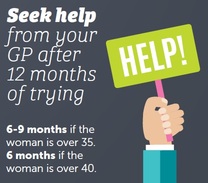Understanding your cycle
Understanding your cycle and being able to identify your fertile window is the most powerful information you can have when wanting to conceive a child.
Menstruation
The first menstruation for a young woman is known as the menarche. It normally occurs in girls between the ages of about 10 and 16, although this age varies in different parts of the world, depending on the girl attaining a minimal body weight and the level of her nutrition.
The menstrual cycle is often irregular to begin with, but it usually settles into a pattern after a couple of years. Menstrual symptoms are often detectable even before the young woman begins menstruation. Usually the menstrual cycle is 28-30 days, which is from Day 1 of bleeding to the next Day 1.
Menopause usually occurs between the ages of 40-55. Often a woman’s menstrual cycles become irregular for 1-3 years before the menopause, and this is called the peri-menopause. Menopause is when menstruation no longer occurs. A woman is considered menopausal when she has not had a period for one year.
The ovaries and egg production
Eggs are laid down in the ovary during foetal development, and reach their maximum number of about seven million three months before birth. By the time the girl is born, the number will have already fallen to about two million, and by puberty, to a few hundred thousand.
At puberty, increasing levels of reproductive hormones allow some eggs to mature and so the menstrual cycle begins. Many more eggs start developing than are ovulated, and by her late thirties the number of eggs left in the ovaries is down to 20,000.
It takes about three months for an egg to undergo maturation. We are just familiar with the last two weeks of development, which occur between day 1 and ovulation. During this time the egg itself does not increase in size, but the blister-like follicle surrounding it grows in size from less than 5mm to 20mm. At ovulation this fluid filled blister bursts, and the ovum is released with the fluid into the vicinity of the adjacent fallopian tube.
Usually a whole crop of follicles, up to 50, start to develop at the beginning of a menstrual cycle, but only one becomes the leading follicle and it is this egg which is released at ovulation. This dominant follicle somehow suppresses its neighbours, so that in a normal cycle only one egg is released, thereby avoiding multiple pregnancies most of the time. The suppressed follicles degenerate and their eggs are absorbed.
The hormone production
Hypothalamus – this is located in the central part of the brain, and produces the hormone GnRH – Gonadotrophin Releasing Hormone. This hormone acts on the Pituitary Gland to release FSH and LH.
Pituitary gland – is about the size of a cherry and is located at the base of the brain behind the bridge of the nose. As well as producing the ovulation hormones FSH and LH, it is involved in the secretion of other hormones including prolactin growth hormone, and hormones stimulating the thyroid gland (in the neck) and adrenal glands (above the kidneys).
FSH – Follicle Stimulating Hormone – is responsible for stimulating the development of follicles in the ovary (In men it stimulates sperm production). In the first few days of the menstrual cycle the FSH level is elevated, and this stimulates the development of a group of follicles in the ovary. As the follicles develop their own hormones ‘inhibit’ the production of FSH, so that only enough is produced to stimulate the growth of the biggest follicle. An abnormally high FSH on Day 2 of the menstrual cycle can indicate declining ovarian reserve (low egg numbers). This may be checked with a blood test on Day 2 of your cycle, and the results should be discussed with your doctor/specialist.
Estradiol – this hormone is produced in the ovaries, by the granulosa cells, which make up the walls of the follicle. The estradiol acts on the pituitary gland and the hypothalamus to reduce the production of FSH. Estradiol is also the hormone responsible for the thickening of the lining of the uterus, the endometrium, and for inducing the production of the fertile cervical mucus, which is copious, clear and elastic. This mucus may be noticed during the middle stages of your cycle, or around the time of ovulation. The estradiol level gradually rises as the follicle develops, reaching its peak level prior to ovulation, and when the follicle is 18-20mm in diameter. Estradiol is the main member of a class of hormones called estrogens.
LH – Luteinizing Hormone – is secreted from the Pituitary Gland at low levels throughout the menstrual cycle. When the ovarian follicle is mature there is a sharp rise in LH production which causes the follicle to rupture and ovulation to occur.
Progesterone – is the hormone produced in the ovary following ovulation. The collapsed follicle is now called the corpus luteum (Latin for Yellow Body). The corpus luteum produces both estradiol and progesterone, and these hormones are responsible for providing an environment in which the embryo can implant into the wall of the uterus and develop. The corpus luteum has only a ‘life’ for 10-14 days, unless conception occurs. Towards the end of this time the oestrogen and progesterone levels drop. Without these hormones, the lining of the uterus begins to break down, its blood vessels rupture and menstrual bleeding begins as the lining sloughs away. If conception does occur, the embryo produces the hormone HCG (Human Chorionic Gonadotrophin) which stimulates the corpus luteum to continue functioning and so maintains the production of estradiol and progesterone. About 7-8 weeks into pregnancy, the placenta takes over the making these hormones. A new menstrual cycle begins when the low levels of estradiol allow FSH levels to increase.
AMH – Anti-Mullerian Hormone – this blood test has only been available in New Zealand since the end of 2008. AMH is a hormone produced by a woman’s ovaries. It is produced by the developing follicle, which contains an egg, and therefore it gives an indication of the number and quality of eggs being produced during a woman’s monthly cycle. New research shows that AMH Assay (blood test) may give a more accurate indication of ovarian reserve that the traditional Day 2 FSH Assay. If you would like this blood test, you need to see your GP or a Fertility Specialist to arrange the test and then to discuss the implications of the results.
Ovulation
Why does a woman need it?
In order for a woman to have a chance of becoming pregnant, ovulation needs to occur. After ovulation the mature egg is passed down the fallopian tube which is able to carry and transport the egg.
Once the egg is inside the fallopian tube it is ready to meet the sperm. If the egg comes into contact with sperm, fertilisation can occur and a pregnancy may result. If the egg does not meet any sperm, it can’t be fertilised and will then be reabsorbed after several days.
When does a woman ovulate?
The actual day of ovulation varies from woman to woman, and can vary slightly each month. As a guide, the length of an average menstrual cycle is 28 days, with ovulation occurring 12-14 days BEFORE the next period is due. To become pregnant it is best to have intercourse 1–2 days prior to and at the time of ovulation. This will give the sperm the best chance of being present within the fallopian tube at the same time as the egg, so that fertilisation may occur.
How does a woman know if she is ovulating?
There are a few signs to look for to help the woman work out when she may be ovulating. These include:
- Before ovulation the vaginal discharge becomes clear, wet and sticky, like uncooked egg white (and becomes receptive to sperm);
- Some women feel abdominal pain around the time of ovulation;
- The woman’s body temperature rises slightly after ovulation;
- After ovulation the vaginal discharge becomes thick and white (and acts as a barrier to sperm).
If a woman is not ovulating, the most common sign is that she does not have a period. Sometimes, however, she may have irregular spotting or light bleeding even though she is not ovulating.
If a woman is unsure whether she is ovulating or not, then her doctor or practice nurse will be able to help her clarify this with blood tests and possibly a urine test.
If a woman is using the oral contraceptive pill, then she will not be ovulating as the hormones within the pill provide sufficient levels to block the woman’s own hormone production. Other forms of contraception (i.e. condom, IUCD) do not affect ovulation.



